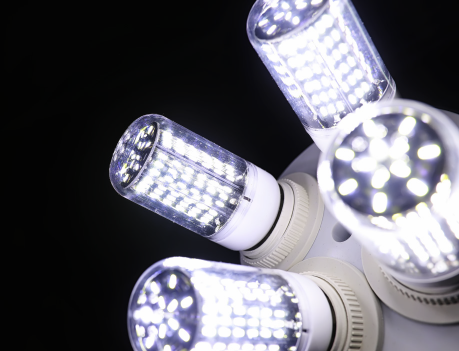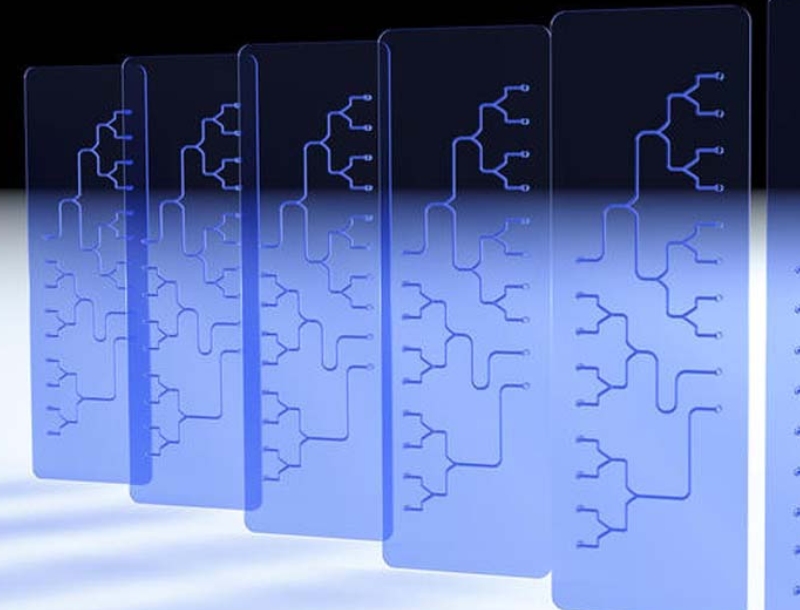LED/Optoelectronics
Explore LED/optoelectronics solutions in creating innovative and transformative products and designs.

Solid-state lighting (SSL)
Solid-state lighting (SSL) refers to the technology used in light-emitting diodes (LEDs) and organic light-emitting diodes (OLEDs) to produce light. Unlike traditional incandescent bulbs or fluorescent lights, which rely on heating a filament or exciting a gas to generate light, solid-state lighting uses semiconductors to convert electrical energy directly into light.
LEDs, the most common form of solid-state lighting, are tiny semiconductor devices that emit light when an electric current passes through them. They are made of a semiconductor material, typically a compound of gallium, indium, and nitrogen (GaN), which produces visible light when electrons recombine with electron holes. The color of the emitted light depends on the specific materials used and the energy bandgap of the semiconductor.
Solid-state lighting offers several advantages over traditional lighting technologies. Here are a few key benefits:
- Energy efficiency: LEDs are highly efficient and convert a higher percentage of electrical energy into visible light compared to incandescent or fluorescent lights. This energy efficiency translates into reduced electricity consumption and lower energy costs.
- Long lifespan: Solid-state lighting has a significantly longer lifespan compared to traditional bulbs. LED lights can last tens of thousands of hours, depending on usage, which means reduced maintenance and replacement costs.
- Durability: LEDs are constructed using solid-state components, making them more robust and resistant to shocks, vibrations, and environmental conditions. They do not have fragile filaments or glass enclosures, making them ideal for various applications, including outdoor and industrial lighting.
- Design flexibility: LED lighting can be easily integrated into various form factors and designs. They are available in different sizes, shapes, and colors, enabling versatile applications in residential, commercial, and architectural lighting.
- Environmental friendliness: LED lighting is more environmentally friendly compared to traditional lighting options. They consume less energy, reducing greenhouse gas emissions, and they do not contain hazardous materials such as mercury, which is present in fluorescent lamps.
Solid-state lighting has revolutionized the lighting industry and is widely used in various applications, including residential lighting, street lighting, automotive lighting, display screens, and backlighting for televisions, computers, and mobile devices. The technology continues to advance, offering even greater efficiency, improved color rendering, and new applications in areas such as horticultural lighting and smart lighting systems.

Thermal Materials
Thermal materials play a crucial role in lighting applications, particularly in managing heat generated by the light source. Excessive heat can degrade the performance and lifespan of lighting components, so effective thermal management is essential to ensure optimal operation and reliability. Here are some important thermal materials used in lighting:
- Heat sinks: Heat sinks are commonly used in lighting fixtures to dissipate heat away from the light source. They are typically made of thermally conductive materials such as aluminum or copper, which have high thermal conductivity. Heat sinks increase the surface area available for heat transfer and use convective airflow to dissipate the heat into the surrounding environment.
- Thermal interface materials (TIMs): TIMs are used to enhance heat transfer between different components in a lighting system, such as between the LED package and the heat sink. TIMs fill the microscopic gaps and air voids that exist at the interface, improving thermal conduction. Common types of TIMs include thermal greases, thermal pads, phase change materials, and thermal adhesives.
- Ceramic substrates: Ceramic substrates, often made of aluminum oxide (Al2O3) or aluminum nitride (AlN), are used in high-power LED applications. These materials have excellent thermal conductivity and electrical insulation properties. Ceramic substrates provide a mechanically robust platform for mounting the LED chips and help to efficiently dissipate heat from the LEDs.
- Thermal adhesives: Thermal adhesives are used to bond heat sinks and other components together, ensuring good thermal contact and heat transfer. They provide mechanical support while also facilitating the conduction of heat. Thermal adhesives typically have good thermal conductivity and electrical insulation properties.
- Encapsulants: Encapsulants are materials used to protect the LED chips from environmental factors and provide mechanical support. Some encapsulants, such as silicone-based materials, offer good thermal conductivity, helping to dissipate heat from the LEDs. Encapsulants also act as a medium for light transmission and can have optical properties to enhance the efficiency of the lighting system.
Thermal management is crucial in high-power lighting applications, such as commercial and industrial lighting, where heat dissipation is a significant challenge. Proper selection and use of thermal materials help to maintain the temperature within acceptable limits, ensuring the longevity and performance of lighting systems.

Advanced Polymers
Advanced polymers play a vital role in LED packaging, providing protection, thermal management, and optical enhancements. Here are some key advanced polymers used in LED packaging:
- Epoxy Resins: Epoxy resins are commonly used in LED encapsulation to protect the delicate LED chips from environmental factors such as moisture, dust, and mechanical stress. Epoxy resins provide excellent adhesion, high transparency, and good electrical insulation properties. They also offer resistance to yellowing and UV degradation, ensuring long-term optical performance of the LEDs.
- Silicone Materials: Silicone-based polymers are widely used in LED packaging due to their excellent thermal stability and high-temperature resistance. Silicone encapsulants and gels offer good optical clarity, flexibility, and resistance to yellowing over time. They provide effective protection against moisture, shock, and vibration, making them suitable for demanding applications.
- Polyimides: Polyimides are high-performance polymers known for their exceptional thermal stability, mechanical strength, and electrical insulation properties. They can withstand high temperatures without degradation, making them suitable for LED packaging in high-power applications. Polyimide films can be used as substrates for flexible LED displays and as protective layers for LED chips.
- Liquid Crystal Polymers (LCP): Liquid crystal polymers are lightweight, high-performance materials with excellent thermal stability, low moisture absorption, and high dimensional stability. LCPs are used in LED packaging as substrates for chip-on-board (COB) technology and in flexible circuit boards for LED modules.
- Polycarbonate (PC): Polycarbonate is a durable and transparent polymer used in LED lenses and covers. It offers high impact resistance, UV stability, and good thermal resistance. Polycarbonate lenses can be designed to provide desired light distribution patterns and optical effects, enhancing the efficiency and aesthetics of LED lighting.
- Thermally Conductive Polymers: Thermally conductive polymers are specialized materials used for thermal management in LED packaging. These polymers combine thermal conductivity with the benefits of polymers, such as flexibility and ease of processing. They can be used as substrates or heat sink materials to efficiently dissipate heat from the LED chips.
Advanced polymers enable improved performance, reliability, and design flexibility in LED packaging. They offer a wide range of properties, including optical clarity, thermal stability, moisture resistance, and mechanical strength, ensuring the long-term functionality and durability of LED lighting systems.

Smart Lighting
Smart lighting refers to a lighting system that incorporates advanced technologies, connectivity, and intelligent control to provide enhanced functionality, energy efficiency, and convenience. Smart lighting systems typically consist of LED light sources, network connectivity, sensors, and control interfaces. Here are some key aspects and features of smart lighting:
- Energy Efficiency: One of the primary advantages of smart lighting is its energy-saving capabilities. Smart lighting systems use energy-efficient LED lights and employ various strategies to minimize energy consumption. These systems can adjust lighting levels based on occupancy, ambient light levels, and user preferences, optimizing energy usage and reducing electricity costs.
- Wireless Connectivity: Smart lighting systems utilize wireless connectivity, such as Wi-Fi, Zigbee, or Bluetooth, to enable communication between various components. This connectivity allows for centralized control and monitoring of the lighting system, either through dedicated smart lighting apps or integrated with smart home automation platforms.
- Automation and Control: Smart lighting systems offer sophisticated control options, allowing users to adjust brightness, color temperature, and even the color of the light. Automation features enable scheduling of lighting scenes, occupancy-based control, and integration with other smart devices and systems. This flexibility enables personalized lighting experiences and convenient control of lighting throughout the day.
- Sensors and Intelligent Features: Smart lighting systems often incorporate sensors, such as motion sensors and ambient light sensors. Motion sensors can detect occupancy in a room and automatically turn on or off the lights, enhancing energy efficiency. Ambient light sensors can adjust the lighting levels based on natural light conditions, maintaining a consistent level of illumination.
- Integration with Smart Home Systems: Smart lighting can be seamlessly integrated with other smart home devices and systems. Integration with voice assistants like Amazon Alexa or Google Assistant enables voice control of the lighting system. Integration with home automation platforms allows for complex scenarios and automation routines, where lighting can be synchronized with other devices, such as security systems or entertainment systems.
- Data Collection and Analytics: Smart lighting systems can collect data about energy usage, occupancy patterns, and user preferences. This data can be analyzed to optimize energy efficiency, identify usage patterns, and make informed decisions for further energy savings or system improvements.
- Enhanced Security and Safety: Smart lighting can enhance security by integrating with security systems to simulate occupancy when homeowners are away. It can also provide safety features such as lighting pathways during emergencies or integrating with smoke or carbon monoxide detectors to activate lights for evacuation.
Smart lighting offers numerous benefits, including energy savings, convenience, customization, and improved functionality. It is widely used in residential, commercial, and outdoor lighting applications, offering a versatile and intelligent approach to lighting control and management.



